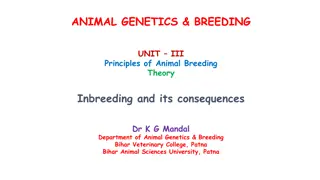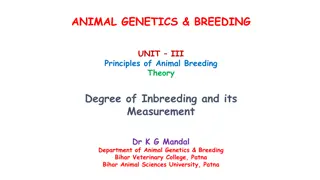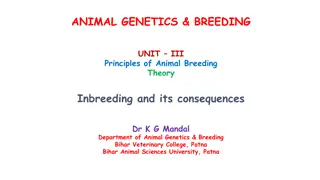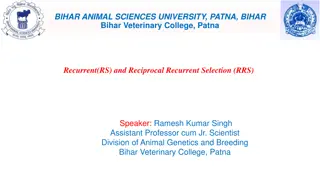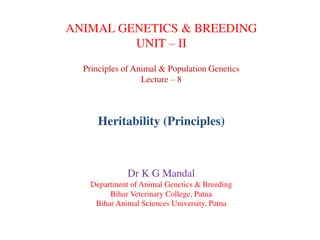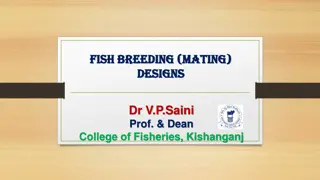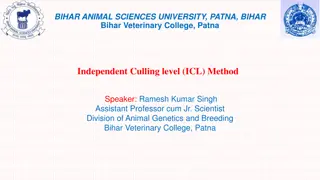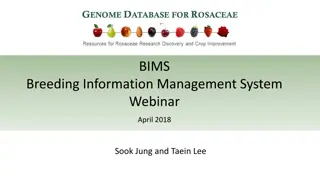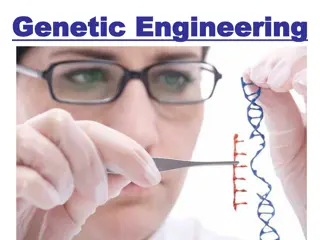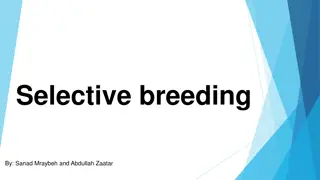Principles of Animal Breeding: Introduction and Historical Perspective
This unit covers the introduction to animal breeding, the application of genetics principles in breeding, historical perspectives including the work of Robert Bakewell, and key events in animal breeding evolution. Topics include breeding systems, importance of animal breeding, and notable figures in the field. Various breeding techniques and methodologies such as inbreeding, assortative mating, and outbreeding are discussed along with the significance of breed associations and registrations.
Download Presentation

Please find below an Image/Link to download the presentation.
The content on the website is provided AS IS for your information and personal use only. It may not be sold, licensed, or shared on other websites without obtaining consent from the author. Download presentation by click this link. If you encounter any issues during the download, it is possible that the publisher has removed the file from their server.
E N D
Presentation Transcript
ANIMAL GENETICS & BREEDING UNIT III Principles of Animal Breeding Theory Introduction to Animal Breeding Dr K G Mandal Department of Animal Genetics & Breeding Bihar Veterinary College, Patna Bihar Animal Sciences University, Patna
Text & reference Books 1. Animal Breeding Plan by Prof. Jay L. Lush 2. Text Book of Animal Breeding by S. S. Tomar 3. Breeding & Improvement of Farm Animals by Warwick and Legates 4. Genetics of Livestock Improvement by J F Lasley 5. Genetics and Breeding of Farm animals by D. P. Mukherjee & G. C. Banerjee
1. Introduction to the subject 2. Objective / Importance 3. Origin historical perspective 4. Breeding system / Breeding methodology (i) Random mating (ii) Assortative mating (iii) Inbreeding (iv) Outbreeding
Introduction to Animal Breeding Breeding ? Application of principles of genetics and quantitative genetics in particular by using biometric techniques improvement of plant or animal is known as breeding. Plant Breeding Animal Breeding Poultry Breeding for genetic
Historical perspective of Animal Breeding Chronological events: 1. Robert Bakewell (1760), popularly known as the Founder of Animal Breeding, worked on Thorough bred horse, Shorthorn cattle his farm at Dishley, England and animal breeding. He developed certain theories, tested them with experiment and laid down the following principles: (i) Like begets like this has led to development of pedigree breeding. (ii) Selected males if they transmitted desirable traits this led to the development of progeny testing. and Leicester sheep became in successful in
(iii) Bred the best to best irrespective of genetic relationship. This has led to the development of inbreeding and pure breeding stock. The greatest contribution of Robert Bakewell to breeding methods was that he appreciated inbreeding as the most effective tool to produce refinement in the breed. 2. Spallanzani (1780) for the first time successfully demonstrated AI in dog. 3. Hunter (1799) successfully produced pregnancy in women through AI. Added for development of AH and further Purebred Breed Association .
4. Formation of Breed Association 5. Breed Registration & introduction of herd book: First herd book was An introduction to the general Stud Book for Thorough bred horse was started in the year 1791. The second herd book was Shorthorn herd book published in 1822. 6. Introduction of pure breeding in India : 1950 1964 7. Cross Breeding was the major policy with breeding in original tract 1964 1997. pure
Breeding System / Mating System Random mating Non-random mating Based on phenotypic resemblance (Assortative mating) Positive Negative Based on Genetic relationship Inbreeding Outbreeding Close breeding Line breeding
Breeding System / Breeding Methodology: A. Random mating: When each and every individual has equal chance of mating with any one individual of opposite sex in a population is known as random mating. It is also known as panmixia. Breeder has no choice in selection of mated individual. B. Non-random mating: (i) Based on phenotypic resemblance : Assortative mating: Like to like mating. (a) Positive assortative mating (b) Negative assortative mating (ii) Based on genetic resemblance: (a) Inbreeding (b) Outbreeding
Inbreeding: Mating of individuals which are more closely related to each other than the average relationship of the population concerned. Related individuals: Two individuals are said to be related if they have common ancestor in the preceding 4 6 generations of their pedigree. Ancestor: An individual which transmits its genetic material to the descendants. Descendant: An individual who receives some of its genetic material from the ancestor.
Common ancestor: Individual who transmits its genetic materials to the inbred through sire s and dam s pedigree of the inbred individual is known as common ancestor. Inbred: The individual which is produced by mating of relatives is known as inbred. Pedigree: Systematic list of all ancestors to which an individual is genetically related. Application of pedigree: (i) To estimate breeding value based on pedigree record. (ii) To facilitate early selection based on pedigree recor. (iii) To estimate genetic parameter (iv) To formulate breeding plan



